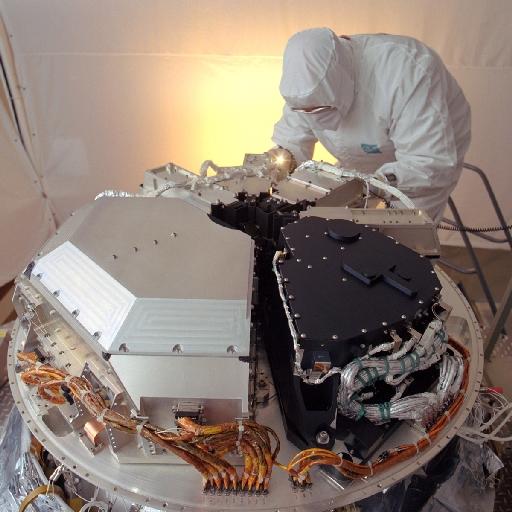

IRAC -
Infrared Array Camera on the
Spitzer Space Telescope

The Spitzer Space Telescope (formerly known as the
Space Infrared Telescope Facility, or SIRTF)
contains three focal plane
instruments, one of which is the Infrared Array Camera (IRAC). IRAC is a
four-channel camera that provides simultaneous 5.2 x 5.2 arcmin images at
3.6, 4.5, 5.8, and 8 microns (the black instrument in the lower right part
of the above image; see the
optical housing model and the
conceptual layout
diagram.
The pixel size is 1.22 arcsec in all bands.
Two adjacent fields of view in the
focal plane are viewed by the four
channels in pairs (3.6 and 5.8 microns; 4.5 and 8.0 microns). All four detector
arrays in the camera are 256 x 256 pixels in size, with the two short wavelength
channels using InSb and the two longer wavelength channels using Si:As IBC
detectors. The IRAC point-source sensitivity requirements
(5 sigma, 200 sec) at 3.6, 4.5, 5.8, and
8.0 microns are 6, 7, 36, and 54 microJanskys, respectively.
The IRAC instrument addresses the four major scientific objectives defining
the Spitzer mission. These objectives are
(1) to study the early universe,
(2) to search for and study brown dwarfs and superplanets,
(3) to study ultraluminous galaxies and active galactic nuclei, and
(4) to discover and study protoplanetary and planetary debris disks. In
addition, IRAC
is a general-purpose camera that has been used by observers for
a wide variety of astronomical research programs.

2003 August 25: Spitzer Space Telescope Launched
The Spitzer Space Telescope was successfully launched from Florida's
Cape Canaveral Air Force
Station at 1:35:39 a.m. Eastern Daylight Time August 25, 2003, aboard a
Delta II launch vehicle.
See the Spitzer Science Center site for
the latest status information and press releases.
2009: The Spitzer Warm Mission/ Beyond Mission
On May 15, 2009, the last of Spitzer's cryogen was depleted. Over the course
of the next couple months as the telescope and instrument chamber warmed, the
IRAC team determined the operating temperature and biases for the warm
mission, and recommissioned the instrument at the new set point. The 3.6 and 4.5 micron channels are operating at nearly the same sensitivity as in the
cryogenic mission, and several enhancements to the spacecraft operation and IRAC
observing modes have been made to improve its performance for various
types of observations, including exoplanets. For details on the warm mission,
see the NASA web site
and the Spitzer Active Mission page. See also the
description of the Beyond Mission.
2020: The End of the Spitzer Mission
On Day 6000 of the Spitzer mission, IRAC was powered down at 2020 Jan 29 20:40:20 UTC. After the remaining science data was transmitted and other spacecraft tasks completed, Spitzer was commanded into Safe Mode at 2020 Jan 30 at 22:30 UTC, ending the mission.
The full public database of Spitzer observations will continued to be hosted on the Spitzer Heritage Archive at IPAC.
Spitzer's orbit will bring the observatory back to encounter the Earth again in 2051.
The IRAC Team
The development of the Infrared Array Camera (IRAC) was a joint
project of the Smithsonian
Astrophysical Observatory (SAO),
Ames Research Center (ARC), Goddard
Space Flight Center (GSFC), the
University of Arizona (UA), and the
University of Rochester (UR).
The Principal Investigator for IRAC is Dr. Giovanni G. Fazio, Senior
Physicist, in the Optical
and Infrared Astronomy Division at the Harvard-Smithsonian
Center for Astrophysics.
Joseph Hora is the IRAC Project Scientist at SAO.
The Program Manager at SAO was Richard S. Taylor.
The instrument was designed and built at Goddard Space Flight Center (Instrument Manager Lois G.
Workman).
IRAC Team List - check here for email and web
pages of the past and present members of the IRAC Team.
IRAC - related links
Other Spitzer sites and Instruments
Public Documents
- The publications page contains pre-launch IRAC papers, and all post-launch
instrument and science papers by members of the IRAC team at SAO.
- List of IRAC GTO programs
Last updated: Tuesday, 27-Apr-2021 15:35:30 EDT




